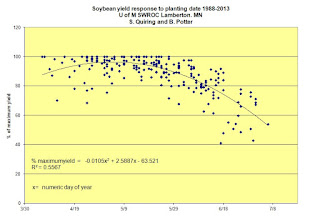By Jeff Coulter and Seth Naeve
Recent storms caused hail damage to crops, especially in central Minnesota. Much of the corn was in the V2 to V3 stage (2 to 3 collared leaves) when damaged, while soybean was in the V1 stage (1 fully-developed trifoliolate leaf) or younger.
In late May, assessing hail damage and making replant decisions can be difficult, with many variables to consider. Answers to many questions regarding crop yield loss and the need for replanting can be found in:
Corn Damage and Replant Guide (48 KB PDF)
Soybean Damage and Replant Guide
Corn
The growing point on corn at the V2 to V3 stage is just below the soil surface and remains below the soil until the V5 to V6 stage (5 to 6 collared leaves). Therefore, hail prior to the V5 to V6 stage typically does not kill corn unless growing points are damaged by large hail stones landing on soft soil or by freezing from hail accumulation around the base of plants.
To determine whether hail-damaged corn will recover, split stalks and examine growing points. Healthy growing points will be firm and white to yellow. If a growing point is damaged it will become water soaked and orange to brown soon after injury, with plant recovery unlikely.
Hail-damaged corn generally shows new leaf growth a few days after injury if the growing point was not damaged. Therefore, assessment of damaged fields should be delayed until at least three days after hail damage. Larger corn plants damaged by hail can resemble buggy whips as new vegetative growth tries to break free of dead tissue. Buggy-whipped plants generally recover, with quicker recovery for smaller plants and when there are warm and windy conditions.
Yield loss in corn due to early-season hail injury is primarily influenced by the reduction in plant population. In Minnesota, reductions in corn grain yield of around 5, 12, and 24% are expected when the population is reduced to 28,000, 22,000, and 16,000 plants per acre, respectively.
Before replanting, consider the yield potential of the existing crop, replanting costs, and the yield potential for a replanted crop. In Minnesota, corn planted in late May yields about 85% of that planted in late April to early May. If replanting, consider the length of the remaining growing season and select hybrids of appropriate maturity.
Additional information on corn production from University of Minnesota Extension is available at: http://z.umn.edu/corn.
Soybean
While soybean is quite resistant to hail damage throughout much of its development, newly emerged soybeans are extremely sensitive to hail. This is especially true with just-emerging plants. As soybeans begin to emerge, the hypocotyl arch is the first tissues to be exposed. This portion of the stem below the cotyledons is very susceptible to damage. Hailstones of any size hitting this tender tissue will cut off the cotyledons. Because the growing point is at the top of the plant, any plants cut off below the cotyledon will die.

Earlier planted soybeans may be in better shape. Soybean plants with significant amounts of green tissue remaining (more than one green cotyledon and/or remaining leaf tissue) are likely to survive early season hail damage, as they can regrow from axillary buds located at the juncture of the stem and leaves.
Before any replant decisions are made, carefully count existing live plants in a known area to determine populations on an acre basis. One method is to count live plants in 1,000th acre (e.g. 17’ 5” of row in 30” rows or 23’ 9” of row in 22” rows). Multiply by 1,000 to estimate plants per acre. To estimate plant population in a solid-seeded field, see this article from NDSU, Established plant density.
Even stands of soybeans above 100,000 per acre will provide full yields at harvest, while stands of about 80,000 will produce 90-95% of the maximum yield potential. Likewise, replanting in the last week of May will likely result in yields of about 90% of those planted during the first week of May. Knowing the break-even point for yields based on existing stands and yield penalties for late planting will allow producers to evaluate the other costs and benefits.
Thin soybean stands are not aesthetically pleasing and will require additional resources for managing weeds. On the other hand, replanting requires additional seed and fuel costs. Only after all of the additional factors including insurance, seed cost, and one’s landlord are carefully weighed, should a producer make the final determination to replant or not.
Source:umn.edu